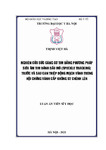
Please use this identifier to cite or link to this item:
http://dulieuso.hmu.edu.vn/handle/hmu/2148| Title: | Nghiên cứu sức căng cơ tim bằng phương pháp siêu âm tim đánh dấu mô (Speckle tracking) trước và sau can thiệp động mạch vành trong hội chứng vành cấp không ST chênh lên. (Ngày công bố: 01/07/2021) |
| Authors: | Trịnh Việt, Hà |
| Advisor: | GS.TS. Đỗ Doãn, Lợi TS. Nguyễn Thị Thu, Hoài |
| Keywords: | 62720141;Nội tim mạch |
| Abstract: | Những kết luận mới của luận án:. 1. Có sự cải thiện sức căng cơ tim bằng siêu âm tim đánh dấu mô sau can thiệp ĐMV ở bệnh nhân HCVC không ST chênh lên. + Sức căng dọc toàn bộ (GLS) cải thiện từ -16,94±3,37% lên -17,31±3,22 (sau 48 giờ) và -18,59±3,34% (30 ngày sau can thiệp ĐMV) với p<0,05.. + Sức căng chu vi toàn bộ (GCS) cải thiện từ -15,91±3,67 (%) lên -17,52±4,03 (%) (sau 48 giờ) và -18,53±5,81 (%) (30 ngày sau can thiệp ĐMV) với p<0,001.. + Sức căng bán kính toàn bộ (GRS) tăng từ 29,77±9,82 (%) lên 30,68±11,06 (%) (sau 48 giờ) và 34,36±10,76 (%) (30 ngày sau can thiệp ĐMV) với p<0,001.. + Tốc độ căng dọc toàn bộ (GLSRs) cải thiện từ -0,99±0,21(1/s) lên -1,04±0,23 (1/s) sau 48 giờ (p>0,05) và -1,07±0,23 (1/s) (30 ngày sau can thiệp ĐMV) với p<0,001.. + Sức căng cơ tim cải thiện rõ ở bệnh nhân can thiệp động mạch liên thất trước (ĐMLTT) thành công. Đặc biệt, sức căng đỉnh tâm thu theo chiều dọc của vùng cơ tim được tưới máu bởi ĐMLTT (p<0,001).. + Can thiệp động mạch thủ phạm là ĐMLTT hay ĐM mũ cải thiện sức căng dọc toàn bộ (GLS) sau can thiệp với OR 2,38 [1,06-5,26], p<0,05.. 2. Mối liên quan giữa sức căng cơ tim với một số biến cố tim mạch chính qua theo dõi 6 tháng.. GLS sau can thiệp ĐMV 48 giờ có giá trị dự báo biến cố tim mạch chính trong 6 tháng sau can thiệp ĐMV với HR= 1,72[1,12-2,89], p<0,05.. Với giá trị cutoff -15,45%, GLS có độ nhạy 85% và độ đặc hiệu 90% trong dự đoán biến cố tim mạch chính sau can thiệp ĐMV với AUC= 0,945 [0,896-0,985], lớn hơn EF (AUC =0,730) và điểm GRACE (AUC =0,666), (p<0,05). New conclusions of the thesis:. 1. There is an improvement in myocardial strain by speckle tracking echocardiography after percutanous coronary intervention (PCI) in non-ST segment elevation ACS.. + Global longitudinal strain (GLS) increased from -16.94 ± 3.37% to -17.31 ± 3.22 % (48 hours) and -18.59 ± 3.34% (30 days) after PCI (p <0.05).. + Global circumferential strain (GCS) increased from -15.91 ± 3.67 (%) to -17.52 ± 4.03 (%) (after 48 hours) and -18.53 ± 5.81 (%) 30 days after PCI (p <0.001).. + Global radial strain (GRS) increased from 29.77 ± 9.82 (%) to 30.68 ± 11.06 (%) after 48 hours and 34.36 ± 10.76 (%) 30 days after PCI (p <0.001).. + Systolic longitudinal strain rate (GLSRs) increased from -0.99 ± 0.21(s-1) to. -1.04 ± 0.23 (s-1) after 48 hours (p> 0.05) and -1.07 ± 0.23 (s-1) 30 days after PCI (p <0.001).. + The culprit artery intervened LAD or LCx is related to improvement in Global longitudinal strain after PCI.. 2. Relationship between myocardial strain with some major cardiovascular events over 6-month follow-up.GLS 48 hours after PCI has statistical significance in predicting major cardiovascular events within 6 months with HR = 1.72 [1.12-2.89], p <0.05. With a cutoff value -15.45%, GLS has sensitivity of 85% and specificity 90% in predicting major cardiovascular events after PCI with AUC 0.945 [0.896-0.985], larger than EF (AUC 0.730) and GRACE score (AUC 0.666), (p<0.05). |
| URI: | http://dulieuso.hmu.edu.vn//handle/hmu/2148 |
| Appears in Collections: | Luận án (nghiên cứu sinh) |
Files in This Item:
| File | Description | Size | Format | |
|---|---|---|---|---|
| 639_00_TVLA_H_35_ Noi TM.pdf Restricted Access | 4.7 MB | Adobe PDF |  Sign in to read | |
| 639_TrinhVietHa_37720.rar Restricted Access | 5.8 MB | WinRAR Compressed Archive |
Items in DSpace are protected by copyright, with all rights reserved, unless otherwise indicated.